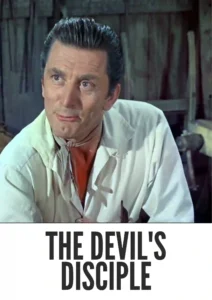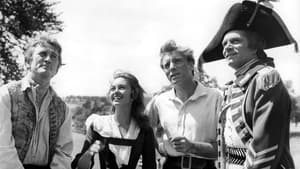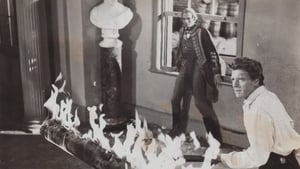Contact: info@alwanfilm.com
Video Sources 0 Views
- Watch trailer
- The Devil's Disciple 1959


Synopsis
Table of Contents
ToggleReview: The Devil’s Disciple 1959 Colorized – A Gripping Revolutionary War Drama Brought to Life in Color

Introduction
“The Devil’s Disciple” (1959) is a captivating film that delves into the complexities of the American Revolutionary War through a tale of unlikely heroism and moral dilemmas. In this article, we’ll explore the significance of this early color film, examining its impact on audiences and its lasting legacy in the world of historical dramas.
Check The Full Colorized Movies List
Check Our Colorized Movies Trailer Channel
Understanding The Devil’s Disciple 1959 Colorized: Director, Cast, and Genre
Directed by the esteemed Guy Hamilton, “The Devil’s Disciple” (1959) showcases his knack for blending intense drama with sharp wit. The film features an impressive cast, including Burt Lancaster, Kirk Douglas, and Laurence Olivier, whose powerful performances elevate the narrative to new heights. This historical drama, interwoven with elements of dark comedy, offers a fresh perspective on the Revolutionary War, making it a standout in the genre.
Exploring the World of The Devil’s Disciple 1959 Colorized: Plot and Characters
“The Devil’s Disciple” (1959) follows the story of Richard Dudgeon (Kirk Douglas), a notorious local troublemaker, and the Reverend Anthony Anderson (Burt Lancaster), who becomes entangled in the fight against British tyranny. Set in 1777, the film captures the tension and turmoil of a nation on the brink of independence. When Dudgeon is mistakenly arrested in place of Anderson, a series of events unfolds that tests their beliefs and courage, ultimately leading to a climactic confrontation with British forces led by General Burgoyne (Laurence Olivier).
The characters are richly drawn, with Dudgeon portrayed as a complex anti-hero whose journey towards redemption is both gripping and inspiring. Anderson, initially a pacifist, undergoes a transformation that highlights the moral ambiguities of war and resistance. The interplay between these characters, set against the backdrop of the Revolutionary War, provides a compelling narrative that is both thought-provoking and emotionally resonant.
The Art of Film Colorization
Film colorization transforms the visual experience of classic movies, adding depth and vibrancy to timeless stories. By digitally adding color to black and white films, colorization allows modern audiences to experience these narratives in a new light, highlighting details and nuances that might have been overlooked in their original format.
Early Colored Films: A Brief History
The journey of colored films dates back to the early days of cinema, where filmmakers experimented with various techniques to introduce color to their creations. From hand-tinted frames to the development of Technicolor, these innovations paved the way for modern colorization methods, enhancing the visual storytelling of countless classic films.
The Devil’s Disciple 1959 and Its Early Colored Version
The decision to release “The Devil’s Disciple” (1959) in a colorized format was met with enthusiasm and skepticism. Colorization aimed to enhance the visual appeal and attract a new generation of viewers, offering a fresh perspective on this historical drama. While purists debated the merits of this choice, the early colored version provided a new dimension to the film’s narrative, making the Revolutionary War era more accessible and visually engaging.
The Debate Over Film Colorization
The ongoing debate over film colorization involves contrasting views on preserving artistic integrity versus modernizing classic films for contemporary audiences. Proponents argue that colorization breathes new life into old films, making them more appealing to younger viewers. Critics, however, contend that it can compromise the original artistic vision and historical authenticity. Despite these differing opinions, colorization remains a significant tool in the preservation and revitalization of classic cinema.
Examining The Devil’s Disciple 1959 as an Early Colored Film
Colorization can enhance the viewing experience of “The Devil’s Disciple” (1959) by adding a new layer of visual interest. The vibrant hues bring the Revolutionary War setting to life, emphasizing the stark contrasts between the characters’ moral choices and the tumultuous backdrop. However, whether this enhancement detracts from or enriches the original black and white aesthetic is subjective and depends on the viewer’s perspective.
Influence and Legacy: The Devil’s Disciple 1959 Colorized’s Impact on Cinema
“The Devil’s Disciple” (1959) has made a lasting impact on historical dramas, inspiring filmmakers to explore complex characters and moral ambiguities within the context of significant historical events. Its unique blend of drama and dark comedy has influenced numerous films, reinforcing the importance of storytelling that challenges audiences to think critically about history and its moral implications.
Director’s Cinematic Legacy: Beyond The Devil’s Disciple 1959 Colorized
Guy Hamilton’s directorial prowess extends beyond “The Devil’s Disciple” (1959), with a distinguished career that includes iconic films like “Goldfinger” and “Diamonds Are Forever.” Hamilton’s ability to balance intense drama with engaging storytelling has left an indelible mark on the film industry, influencing both contemporary and future filmmakers.
Themes Explored in The Devil’s Disciple 1959 Colorized
“The Devil’s Disciple” (1959) delves into themes of heroism, sacrifice, and moral ambiguity. The film explores the complexities of resistance against tyranny, the personal cost of war, and the transformative power of courage and conviction. Through its richly drawn characters and gripping narrative, the film invites audiences to reflect on the nature of heroism and the ethical dilemmas inherent in times of conflict.
Reception and Controversy Surrounding The Devil’s Disciple 1959 Colorized
Upon its release, “The Devil’s Disciple” (1959) garnered critical acclaim for its strong performances, sharp script, and engaging direction. However, the decision to colorize the film reignited debates about the practice’s impact on artistic integrity. Despite the controversy, the colorized version succeeded in drawing a new audience to this classic film, demonstrating the enduring appeal of its powerful story and characters.
Where to Watch The Devil’s Disciple 1959 Colorized Online
For those eager to experience “The Devil’s Disciple” (1959), the film is available on popular streaming platforms such as Amazon Prime, Hulu, and HBO Max. Whether you choose to watch the original black and white version or the colorized edition, the film promises a captivating journey through the complexities of the Revolutionary War and the timeless struggle for freedom and justice.
FAQs About The Devil’s Disciple 1959 Colorized
Q: Is “The Devil’s Disciple” (1959) based on a true story? A: While “The Devil’s Disciple” (1959) is not based on a true story, it is adapted from a play by George Bernard Shaw, who drew inspiration from the historical context of the American Revolutionary War to craft a fictional narrative that explores themes of heroism and moral complexity.
Q: Who are the main actors in “The Devil’s Disciple” (1959)? A: The film features an ensemble cast led by Kirk Douglas as Richard Dudgeon, Burt Lancaster as Reverend Anthony Anderson, and Laurence Olivier as General John Burgoyne. Their performances bring depth and intensity to the film’s exploration of character and conflict.
Q: What awards did “The Devil’s Disciple” (1959) win? A: While “The Devil’s Disciple” (1959) did not win any major awards, it received critical acclaim for its strong performances and compelling narrative, solidifying its place as a memorable entry in the genre of historical dramas.
Q: Why was “The Devil’s Disciple” (1959) released in a colorized format? A: The decision to release “The Devil’s Disciple” (1959) in color was made to introduce the film to a new generation of viewers and enhance its visual appeal for modern audiences. While the choice to colorize the film sparked debate among purists, it ultimately allowed “The Devil’s Disciple” (1959) to reach a wider audience and ensure its continued relevance in the annals of cinematic history.
Q: How does the colorized version of “The Devil’s Disciple” (1959) differ from the original? A: The colorized version of “The Devil’s Disciple” (1959) enhances the visual experience by adding vibrant hues to the film’s settings and characters. This change offers a fresh perspective on the narrative, emphasizing details that might have been overlooked in the original black and white version. However, some viewers may feel that the colorization detracts from the film’s historical authenticity and original artistic intent.
Q: Where can I watch “The Devil’s Disciple” (1959) in its original black and white format? A: The original black and white version of “The Devil’s Disciple” (1959) is available on several streaming platforms, including Amazon Prime and HBO Max. These platforms offer both the original and colorized versions, allowing viewers to choose their preferred viewing experience.
Q: What is the historical context of “The Devil’s Disciple” (1959)? A: “The Devil’s Disciple” (1959) is set during the American Revolutionary War, a period of intense conflict and upheaval as the American colonies fought for independence from British rule. The film uses this historical backdrop to explore themes of resistance, loyalty, and personal sacrifice, offering a nuanced portrayal of the era’s moral complexities.
Q: Who wrote the original play that “The Devil’s Disciple” (1959) is based on? A: The film is adapted from a play by George Bernard Shaw, a renowned playwright known for his sharp wit and incisive social commentary. Shaw’s original work provides the foundation for the film’s exploration of character and conflict, blending historical drama with elements of dark comedy.
Q: What makes “The Devil’s Disciple” (1959) a standout film in the historical drama genre? A: “The Devil’s Disciple” (1959) stands out in the historical drama genre due to its compelling narrative, strong performances, and unique blend of drama and dark comedy. The film’s exploration of moral ambiguity and personal transformation, set against the backdrop of the Revolutionary War, offers a thought-provoking and emotionally resonant viewing experience that continues to captivate audiences.
Q: How has “The Devil’s Disciple” (1959) influenced modern cinema? A: “The Devil’s Disciple” (1959) has influenced modern cinema by demonstrating the power of character-driven storytelling within historical contexts. Its success has inspired filmmakers to explore complex themes and moral dilemmas in their works, contributing to the continued evolution and richness of the historical drama genre.
Conclusion
“The Devil’s Disciple” (1959) remains a compelling exploration of heroism, moral ambiguity, and the transformative power of personal conviction set against the backdrop of the American Revolutionary War. With its strong performances, engaging narrative, and the added dimension of colorization, the film continues to captivate audiences, offering a fresh perspective on a timeless story.
As we reflect on the legacy of “The Devil’s Disciple” (1959), we are reminded of the enduring power of cinema to transport us to different times and places, challenging us to think critically about history and the human condition. Whether viewed in its original black and white format or the early colored version, “The Devil’s Disciple” (1959) remains a testament to the power of storytelling and the resilience of the human spirit.
For those seeking to experience this cinematic gem, “The Devil’s Disciple” (1959) is readily available on popular streaming platforms. Take a moment to immerse yourself in this gripping tale of courage, sacrifice, and redemption, and discover why it continues to resonate with audiences more than six decades after its release.













